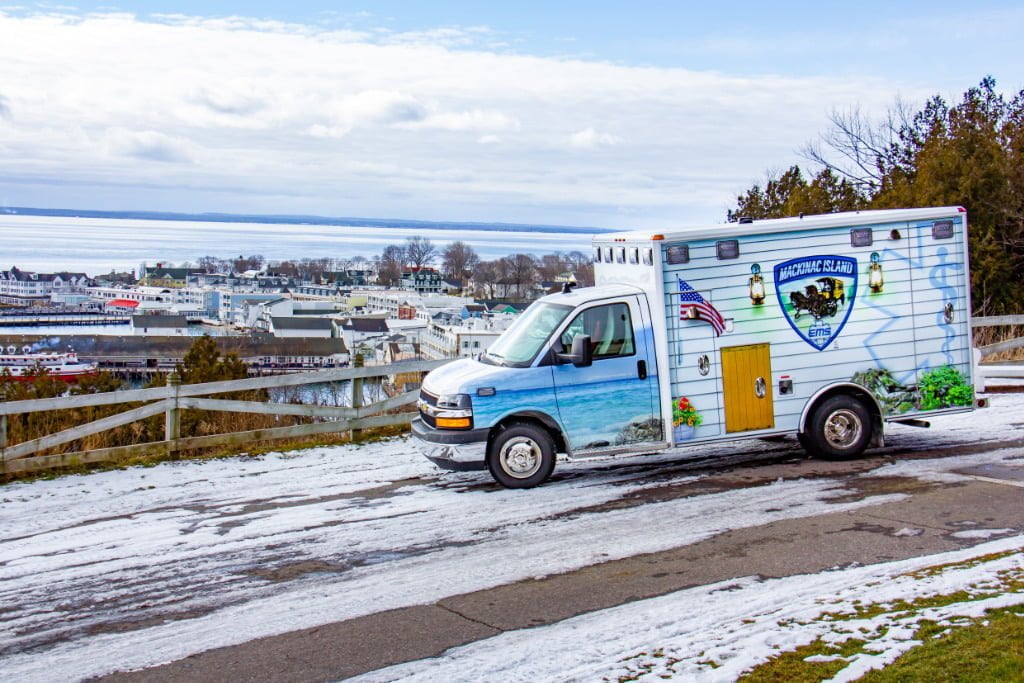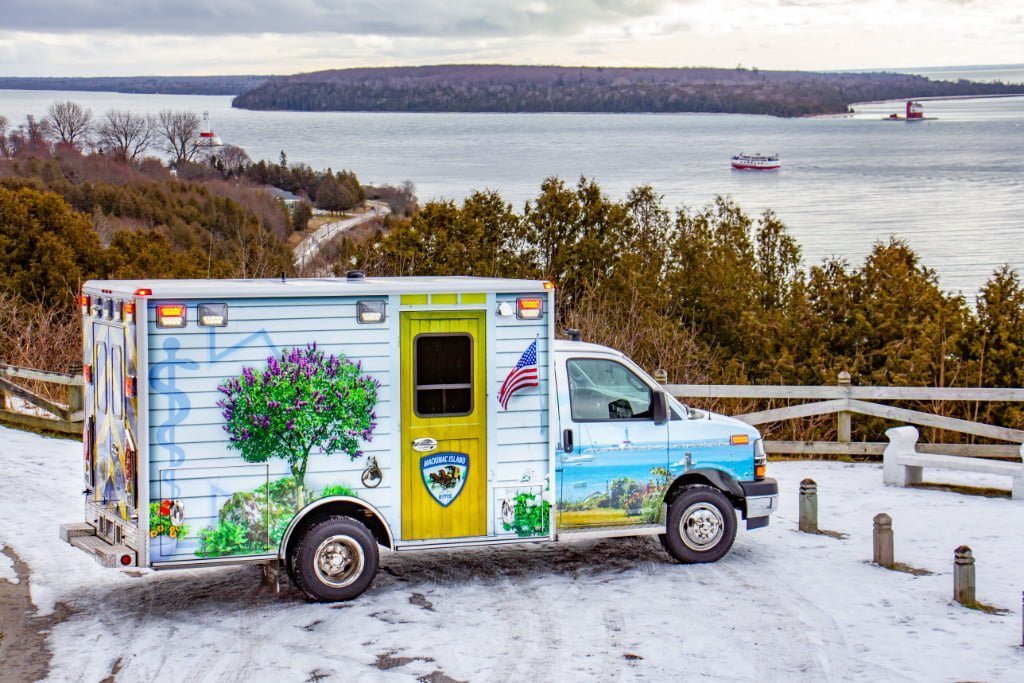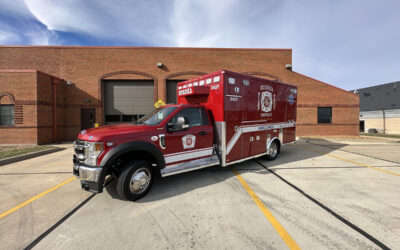
Wheeled Coach built this Citi Medic Type III ambulance on a Chevy G3500 chassis with independent front suspension for Mackinac Island (MI) EMS. (Photos courtesy of Mackinac Island EMS.)
By Alan M. Petrillo
Mackinac Island sits in Lake Huron to the east of southern tip of Michigan’s Upper Peninsula, and travel to the island is by ferry or private boat only. Getting around the island means walking, bicycling, on horseback, or by horse and carriage, and in winter by snowmobile, as no motor vehicles are allowed. The only ones on the island are for emergency services: three fire trucks, three police vehicles and one ambulance.
Related: Road Rescue Delivers Four Type 1 Ambulances to Lexington County (SC) EMS

The new Mackinac Island ambulance has four-wheel drive installed by Quigley 4×4, and is powered by a 6-liter V* gasoline engine, and an automatic transmission.
Mackinac Island EMS had been running a four-wheel drive Ford Econoline van ambulance for 15 years, and needed a new rig to service the island community. Wendy Dawson, Mackinac Island EMS’ manager, says the department was looking to upgrade the size of the rig, get better and safer storage, keep the four-wheel drive option and get a smaller patient box. “We wanted a mini modular box on the new ambulance because of our narrow roads,” Dawson observes. “Also there’s constant horse traffic with drays and carriages pulled by a pair of horses, and in summer, tourist carriages pulled by three horses. We also have to negotiate a lot of narrow passages, bike paths and trails.”

Because of the many narrow roads on the island, Mackinac Island EMS had Wheeled Coach build the ambulance module with a width of 90 inches, and length of 126 inches, with 72 inches of headroom.
Scott Schalow, ambulance sales manager for Emergency Vehicles Plus, says Mackinac Island EMS placed an order with him for a Wheeled Coach Citi Medic Type III ambulance on a Chevy G3500 chassis with independent front suspension. “We got the chassis from Molle Chevrolet in Michigan, who drop shipped it to Quigley 4×4 in Pennsylvania who installed the four-wheel drive with all OEM (original equipment manufacturer) parts so the warranty remains valid,” Schalow says. “When Quigley was finished, they shipped the chassis to Wheeled Coach in Florida, and when the rig was finished there, it was shipped to us in Michigan for some finishing touches.”
Related: University of Minnesota Launches Mobile ECMO Truck with Virtual Reality Component
Schalow notes that the Wheeled Coach Type III rig is powered by a 6-liter V8 gasoline engine, and an automatic transmission, with a patient module that is 126 inches long, 90 inches wide, and has 72 inches of headroom. “There’s no CPR seat in the module,” he points out, “because that’s where we placed the Lifepac monitor bracket. We also constructed two cabinets covered by ROM rollup doors with Rutheford Controls International (RCI) electronic locks for the crew’s medical drug supplies, and all doors and compartments can be locked remotely.”

The Wheeled Coach rig was delivered by Emergency Vehicles Plus by ferry, which is the only way to access the island.
The Type III’s attendant seat swivels and slides, Schalow says, and has a child safety seat inside of it. The curb side of the patient module has double squad bench seating, and all seats are protected by Performax four-point deceleration harnesses.
Dawson says that Mackinac Island EMS upgraded the new rig with a Stryker PowerLOAD system and cot, a new Zoll monitor system built into a moveable monitor stand, and an automated CPR device. She notes that the new rig has a Safety Vision backup and side cameras, as well as a camera inside the patient module so the driver can see what’s happening back there.
The department had concerns about the brightness of the LED lighting that would be used on the new ambulance, Dawson says, worrying that bright lights might spook the horse traffic on the island, but Schalow was able to solve that problem. Schalow says the rig has 20 Teq Nic LED 9-b-7-inch lights around the perimeter, each with the upper half warning and the lower half scene lighting with brightness reduced 50 percent. The ambulance also has a Whelen remote controlled LED spotlight on its roof.

Mackinac Island EMS paramedics and emergency medical technicians pose with their new rig.
Dawson points out that the purchase of the ambulance was funded through the Mackinac Island Community Foundation Ambulance Fund, Father and Son, and the Island Old Goats sailing group. Mackinac Island EMS has 14 paid on-call paramedics and emergency medical technicians (EMTs) on duty in the summer, when the island’s population often swells by 20,000 tourists, and four staff on duty in winter. “The ambulance is parked inside the medical center building near the emergency room,” Dawson says, “and our medics respond from home by bicycle in summer or snowmobile in winter to roll the ambulance to a call. It’s staffed with two paramedics and one EMT in summer, and one paramedic and one EMT in winter.”
ALAN M. PETRILLO is a Tucson, Ariz.-based journalist, the author of three novels and five non-fiction books, and a member of the Fire Apparatus & Emergency Equipment editorial advisory board. He served 22 years with Verdoy (NY) Fire Department, including the position of chief.




